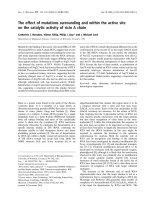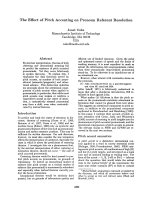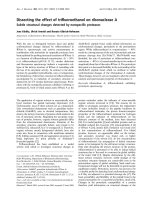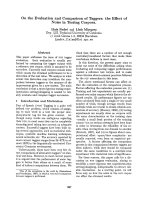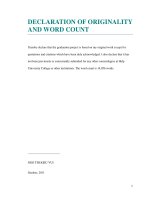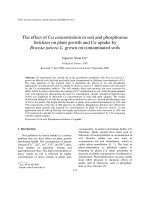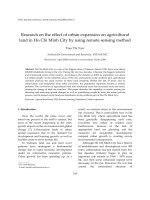the effect of accounting regulation on second-tier audit firms and their clients audit pricing and quality, cost of capital, and backdating of stock options
Bạn đang xem bản rút gọn của tài liệu. Xem và tải ngay bản đầy đủ của tài liệu tại đây (1.86 MB, 151 trang )
THE EFFECT OF ACCOUNTING REGULATION ON
SECOND-TIER AUDIT FIRMS AND THEIR CLIENTS:
AUDIT PRICING AND QUALITY, COST OF CAPITAL, AND
BACKDATING OF STOCK OPTIONS
A dissertation submitted to the
Kent State University Graduate School of Management
in partial fulfillment of the requirements
for the degree of Doctor of Philosophy
by
Magdy Farag
October 2007
UMI Number: 3286211
3286211
2008
UMI Microform
Copyright
All rights reserved. This microform edition is protected against
unauthorized copying under Title 17, United States Code.
ProQuest Information and Learning Company
300 North Zeeb Road
P.O. Box 1346
Ann Arbor, MI 48106-1346
by ProQuest Information and Learning Company.
ii
Dissertation written by
Magdy Farag
B.S., Alexandria University, 1996
M.B.A., Arab Academy for Science and Technology, 2000
Ph.D., Kent State University, 2007
Approved by
________________________ Chair, Doctoral Dissertation Committee
Dr. Pervaiz Alam
________________________ Members, Doctoral Dissertation Committee
Dr. Michael Pearson
________________________
Dr. Richard Brown
________________________
Dr. David Booth
Accepted by
________________________ Doctoral Director, Graduate School of Management
Dr. James Boyed
________________________ Dean, Graduate School of Management
Dr. Frederick Schroath
iii
ACKNOWLEDGMENT
I would like to thank my dissertation chair, Dr. Pervaiz Alam, for his valuable guidance
and encouragement. His support made this dissertation possible. Special thanks also go to the
members of my dissertation committee, Dr. Michael Pearson, Dr. Richard Brown, and Dr.
David Booth, for their support and advice.
I would like to acknowledge the support I received from my family. I would like to
thank my mother Maggy and my father Samir for their love and support with no limits
throughout my life.
iv
TABLE OF CONTENTS
Page
CHAPTER 1 INTRODUCTION
1.1 Recent Regulatory Changes………………………………………… … 1
1.2 Research Questions…………………………………………… ………. 4
1.3 Research Hypotheses and Expectations……………………………… 6
1.4 Summary of Results …………………………………………………… 8
1.5 Research Contribution………………………………………… ………. 10
1.6 Summary………………………………………………….………… 11
CHAPTER 2 BACKGROUND AND LITERATURE REVIEW
2.1 Agency Theory and the Audit Profession ……………………………… 13
2.2 Supplier Concentration in the Market for Audit Services …………… 15
2.3 Audit Quality …………………………………………………………… 20
2.4 Cost of Capital …………………………………………………………. 25
2.5 Backdating of Executive Stock Options ……………………………… 28
2.6 Summary ……………………………………………………………… 31
CHAPTER 3 HYPOTHESES AND METHODOLOGY
3.1 Hypotheses .………………………………………………………………. 33
3.2 Methodology …………………………………………………………… 39
3.2.1 Audit Fees of Second-Tier Audit Firms …………………………………. 39
3.2.2 Audit Quality and Cost of Capital …… ……………………………… 42
3.2.3 Cost of Capital Components …………………………………………… 47
3.2.4 Backdating of Stock Options …………………………………………… 51
CHAPTER 4 RESULTS
4.1 Introduction ………………………………………………………………. 53
4.2 Results for Audit Fees of Second-Tier Audit Firms …………………… 53
4.2.1 Sample …………………………………………………………………… 53
4.2.2 Descriptive Statistics …………………………………………………… 55
4.2.3 Non-Parametric Tests ……………………………………………………. 64
4.2.4 Audit Pricing Model …………………………………………………… 66
4.3 Results for Audit Quality of Second-Tier Audit Firms …… ………. … 70
4.3.1 Sample …………………………………………………………………… 70
4.3.2 Descriptive Statistics ……………………………………………………. 70
4.3.3 Audit Quality and Audit Firm ……………………………………………. 75
4.4 Results for Cost of Capital ……………………………………………… 81
v
4.4.1 Sample …………………………………………………………………… 81
4.4.2 Descriptive Statistics …………………………………………………… 81
4.4.3 Results for Cost of Debt …………………………………………………. 84
4.4.4 Results for Cost of Equity ………………………………………………. 87
4.5 Backdating of Executive Stock Options …………………………………. 91
4.5.1 Sample ………………………….……………………………………… 91
4.5.2 Backdating Results ………………………………………………………. 92
4.6 Supplemental Tests……………………………………………………….103
4.7 Econometric Issues ………………………………………………………115
CHAPTER 5 CONCLUSIONS, LIMITATIONS, AND FUTURE RESEARCH
5.1 Introduction ………………………………………………………………116
5.2 Summary and Conclusions ……………………….………………………116
5.3 Contributions…………………………………………………………… 123
5.4 Limitations and Future Research………………………………………….124
APPENDIX 1 Alternative Measures of Cost of Equity………………………. 126
APPENDIX 2 Converting the Natural Log Values of Audit Fees to their
Original Dollar Values………………………………………… 130
REFERENCES ……………………………………………………….…………. 133
vi
LIST OF FIGURES
Page
Figure 1: Cumulative Abnormal Returns around ESOs Grants for Clients
of Second-Tier audit Firms…… 93
Figure 2: Cumulative Abnormal Returns around ESOs Grants for Clients
of Big-Audit Firms…… 95
Figure 3: Cumulative Abnormal Returns around ESOs Grants for Clients
of Second-Tier Audit Firms and Big-Audit Firms …………… … 96
Figure 4: Cumulative Abnormal Returns around ESOs Grants for Clients
of Second-Tier Audit Firms in the Pre- and Post-SOX Periods… 101
vii
LIST OF TABLES
Page
Table 1: Selection procedure and distribution of sample by audit firm size…… 54
Table 2: Descriptive statistics of audit fees and control variables …….……… 56
Table 3: Correlation coefficients for audit fees and control variables …… 62
Table 4: Change in audit fees of second-tier audit firms: Univariate tests …… 65
Table 5: The audit pricing model regression results ………………… …… 67
Table 6: Descriptive statistics of audit quality and control variables … …… 71
Table 7: Correlation coefficients for audit quality and control variables … …… 74
Table 8: Audit quality and audit firm regression results …………….… …… 76
Table 9: Audit quality and SOX period regression results….…… …….… … 78
Table 10: Audit quality and audit fees regression results….…………….… … 80
Table 11: Descriptive statistics of cost of capital and control variables …… … 82
Table 12: Correlation coefficients for cost of capital and control variables …… 83
Table 13: Cost of debt regression results……………………………………… 86
Table 14: Cost of equity regression results………………………………………. 88
Table 15: Cumulative abnormal returns around executive stock option grants 97
Table 16: Differences in cumulative abnormal returns around executive stock
option grants between second-tier audit firms and big-audit firms ………………. 99
Table 17: Differences in cumulative abnormal returns around executive stock
option grants for clients of second-tier audit firms in the pre- and post-SOX
periods …………………………………………………………………………… 102
Table 18: Discretionary accruals and audit firm regression results ….… …… 106
Table 19: Discretionary accruals and SOX period regression results …… … 108
viii
Table 20: Discretionary accruals and audit fees regression results….……… … 110
Table 21: Cost of debt sensitivity analysis regression results ……………… 111
Table 22: Cost of equity sensitivity analysis regression …………………………. 113
Table 23: Hypotheses results summary ……………….…………………………. 122
CHAPTER 1
INTRODUCTION
1.1 Recent Regulatory Changes
The accounting profession has recently been affected by major financial reporting
scandals and regulatory changes.
1
Prior to November 2000, the U.S. Securities and Exchange
Commission (SEC) did not explicitly address many of the non-audit services auditors were
performing. In November 2000, the SEC amended its auditor independence rules and
significantly revised the types of non-audit services that auditors could provide to their audit
clients. The SEC also required publicly traded firms to disclose fees from two categories of
non-audit service: financial information systems design and implementation, and other fees
(U.S. SEC 2000). The Sarbanes-Oxley Act of 2002 (SOX) further addressed auditor
independence. Specifically, Section 201(a) of SOX expressly prohibits eight types of non-audit
services,
2
as well as any other service that the firms’ board of directors determines that the
auditors are not permitted to provide to their public company audit clients. SOX further
provides that a registered public accounting firm may engage in non-audit services, including
tax services, only if the activity is approved in advance by the audit committee of the board of
directors.
1
Major scandals include the bankruptcy of Enron and WorldCom, the demise of Arthur Andersen, the
major stock market crash in 2000, and the most comprehensive securities market reforms since the
1930s.
2
The eight specific prohibited services are: (1) bookkeeping or other services related to the accounting
records or financial statements of the audit client, (2) financial information system design and
implementation, (3) appraisal or valuation services, fairness opinions, or contribution-in-kind reports, (4)
actuarial services, (5) internal audit outsourcing services, (6) management function or human resources,
(7) broker or dealer, investment advisor, or investment banking services, and (8) legal services and expert
services unrelated to the audit.
1
2
As mandated by SOX requirements, the SEC, on February 5, 2003, issued a new
auditor independence rule, “Strengthening the Commission's Requirements Regarding Auditor
Independence.” The SEC 2003 Independence Rules, which generally took effect on May 6,
2003, expressly prohibits the same eight non-audit services specified in SOX. The restriction
of tax services was heavily debated by many interested parties when the SEC began drafting
these rules. Ultimately, the SEC ruled not to prohibit tax services at that time, but it did caution
audit committees to inspect the nature of the tax services that auditors might provide before
approving these services. The SEC also required all publicly traded firms to disclose in their
annual proxy statement, or other appropriate filing, the audit and non-audit fees paid to the
auditor for the two most recent fiscal years and certain other information about non-audit fees
classified as audit-related, tax, and all other fees (U.S. SEC 2003).
Accounting research is currently investigating these recent regulatory changes and how
they affect the accounting profession. There is a concern for the relationship between
independent auditors and their clients in terms of audit quality, audit services, audit fees, and
other variables that affect the auditor-client relationship after the implementation of these
regulations (e.g., Francis and Wang 2005; Krishnan 2005; Krishnan et al. 2005). Although the
entire accounting profession has been affected by these regulations, most accounting research
focuses only on Big-audit firms,
3
especially after their concentration, as the major providers of
3
In this study, Big-audit firms refers to large public accounting firms. These firms differ from other
audit firms by their total revenues, size, and global reach. The Big-audit firms were called the Big-8
audit firms in the 1970s and the 1980s. The Big-8 consisted of Arthur Andersen, Arthur Young, Coopers
& Lybrand, Ernst & Whinney, Deloitte, Haskins & Sells, Peat Marwick International, Price Waterhouse
& Touche Ross. In 1989, Ernst and Whinney merged with Arthur Young to become Ernst and Young
and Deloitte, Haskins & Sells merged with Touche Ross to become Deloitte & Touche. From 1989, the
Big-audit firms were referred to as the Big-6. Price Waterhouse merged with Coopers & Lybrand in
1998 to become PricewaterhouseCoopers and the Big-6 became the Big-5. Arthur Andersen collapsed
after the firm’s indictment for obstruction of justice involving Enron in 2002, and the Big-5 became the
Big-4. Peat Marwick International became KPMG. Hence the Big-4 now consists of
3
high quality audit services. However, there has been very little attention devoted to Second-
Tier (Non-Big) audit firms.
4
Big-audit firms have been traditionally classified as the provider of higher quality
audits, and previous research provides evidence in such terms (e.g., Blokdijk et al. 2006;
Defond and Francis 2005; Jensen and Payne 2005). Although, in theory, it is assumed that all
accounting firms, whether big or small, can provide a competent audit in accordance with
Generally Accepted Auditing Standards (GAAS), previous research has shown that smaller
audit firms have higher litigation rates, report less conservatively, and have clients that are
more likely to have abnormal accruals. Abnormal accruals provide evidence of more
aggressive earnings management taking place for firms audited by Second-Tier audit firms
(Pittman and Fortin 2004). It is the auditor’s choice whether or not to provide higher quality
audits and there are clients that demand such higher quality audits.
The dominant Big-audit firms audit mostly large publicly-traded U.S. companies (U.S.
GAO 2003). However, there are still a large number of small publicly-traded companies
audited by local and regional accounting firms. There is evidence that Big-audit firms are
eliminating more of their riskier clients, especially post-SOX. As a consequence, these clients
are being engaged by the Second-Tier audit firms (PAR 2005). Given their larger client base,
Big-audit firms have more to lose than Second-Tier audit firms in regards to their loss of
reputation. Therefore, Big-audit firms have greater incentives to protect their reputation than
Second-Tier audit firms (Khurana and Raman 2004).
PricewaterhouseCoopers, KPMG, Ernst & Young and Deloitte Touche Tohmatsu. I use the term “Big-
audit firms” throughout the study to refer to the above set of large international accounting firms.
4
Some studies refer to audit firms other than the Big-audit firms as “Non-Big audit firms” (e.g., Khurana
and Raman 2004; Blokdijk et al. 2006; Fernando et al. 2006; Francis et al. 2005). However, other studies
subdivide Non-Big audit firms into Second-Tier audit firms and Small-audit firms (e.g., Tendeloo and
Vanstraelen 2005).
4
Previous accounting research has not fully investigated Second-Tier audit firms and
their clients. The objective of this study is to examine the effect of the above-mentioned
regulatory changes in the accounting profession on Second-Tier audit firms. Second-Tier audit
firms are expected to be influenced by recent accounting scandals and new regulations in terms
of their audit fees, audit quality, and their clients’ characteristics, especially after the major
accounting scandals.
1.2 Research Questions
The research questions in this study are motivated by agency theory. The agency
theory of the firm focuses on the relationship between the principal (stockholders) and the agent
(management). The agent has certain obligations, which he fulfills for the principal by virtue of
the economic contract (Culpan and Trussel 2005). The important concept in the agency
relationship is the selection of the appropriate governance mechanism between the principal
and the agent that will ensure an efficient alignment of the principal’s and the agent’s interests.
Thus, agency theory would be an appropriate framework to demonstrate and explain the effect
of recent regulations on audit firms that serve as the moderator in the principal-agent
relationship.
This study addresses four research questions. First, it examines whether clients of
Second-Tier audit firms incur higher audit fees subsequent to the recent accounting regulation.
Specifically, it determines whether there is an association between the audit market
concentration and the price for audit services in Second-Tier firms. Economic theory predicts a
positive relationship between auditor concentration and audit fees (Pearson and Trompeter
1994). However, previous research has not investigated empirically the association between
audit firm concentration and audit fees of Second-Tier audit firms.
5
The second research question is whether quality of audits provided by Second-Tier
audit firms is expected to change due to rigid regulations and rulings, especially in the post-
SOX period. It is also possible that Second-Tier audit firms may not be able to provide high
quality audits in their efforts to increase their market share.
Third, this study investigates whether clients of Second-Tier audit firms experience a
higher cost of capital compared to clients of Big-audit firms. The cost of capital area of
research is substantially related to financial and capital markets research. Client firms that are
audited by Second-Tier audit firms are expected to receive lower quality audits compared to
client firms that are audited by Big-audit firms. This lower quality audits are reflected in their
earnings quality. Previous research employs two approaches for deriving measures of earnings
quality. One is based on estimates of abnormal accruals and the other is based on the extent to
which working capital accruals map into cash realizations (e.g., Aboody et al. 2005; Francis et
al. 2005). Lower quality accruals are associated with larger costs of debt and equity due to the
information risk (Francis et al. 2005). This study examines the relationship between client
firms that hired Second-Tier audit firms and the cost of debt and equity for these firms.
Engaging a Big-audit firm, which has the reputation for supplying a higher quality audit that
enhances the credibility of the financial statements, enables firms to reduce their financing costs
(Pittman and Fortin 2004). In contrast, this study predicts that firms that are audited by
Second-Tier audit firms are subject to larger financing costs measured by higher costs of debt
and equity. Although prior research examines the role of auditor choice on the cost of capital
and the cost of debt for public firms, there is no evidence on the effect of audit quality of Big-
audit firms and Second-Tier audit firms on the cost of capital of their clients, especially in the
post-SOX period.
6
The final research question addresses whether there is a relationship between clients of
Second-Tier audit firms and the backdating of executive stock options (ESOs). It is expected
that clients of Second-Tier audit firms exercise backdating of ESOs more often than clients of
Big-audit firms. Backdating of ESOs is only one form of dating games that executives play.
Backdating involves the executive designating the grant date at a date before the board makes
the decision to grant options. This is done to obtain options at a lower exercise price since the
exercise price is usually set equal to the stock price prevailing on the designated grant date. It
is worthwhile to backdate only if the stock price has been rising in the days before the board
decision date (Narayanan et al. 2006). This study develops a test that relates stock cumulative
abnormal returns (CAR) patterns around the grant date for clients of Second-Tier audit firms in
comparison to CAR patterns for clients of Big-audit firms. This test helps in detecting the
backdating of ESOs. If executives are backdating options, a longer reporting lag implies that,
on average, they were backdating aggressively, seeking a lower exercise price. This suggests
that stock price increases following the manager-designated grant date will be positively
correlated with the reporting lag. It is expected that auditor can help in reducing these
backdating practices. Since Big-audit firms are characterized as providers of high quality
audits, it is expected that they are capable of preventing exercises of backdating of ESOs more
efficiently than Second-Tier audit firm.
1.3 Research Hypotheses and Expectations
Four sets of hypotheses are developed to investigate the research questions in this
study. The first hypothesis asserts that audit fees paid to Second-Tier audit firms are higher in
the post-2002 period (post-SOX) when compared to the pre-2002 period (pre-SOX). The
second set of hypotheses emphasizes that audit quality provided by Second-Tier audit firms is
7
less than audit quality provided by Big-audit firms in the post-2002 period, and that audit
quality provided by Second-Tier audit firms declined in the post-2002 period. The third set of
hypotheses covers the cost of capital issues and states that cost of debt for clients of Second-
Tier audit firms is higher than cost of debt for clients of Big-audit firms. Similarly, the cost of
equity for clients of Second-Tier audit firms is higher than cost of equity for Big-audit firms’
clients. In respect to the backdating of ESOs issue, the fourth hypothesis states that clients of
Second-Tier audit firms exercise backdating of ESOs more frequently than clients of Big-audit
firms.
The approach taken to test the difference between pre- and post-SOX audit fees paid to
Second-Tier audit firms is based on a regression model that regresses audit fees on an indicator
variable that differentiates between the two periods and a set of control variables that are
considered the determinants of audit fees throughout the audit fees literature. To measure audit
quality, a model that is based on the modified Dechow and Dichev’s (2002) model of accruals
quality is used. The standard deviation of the unexplained portion of the variation in total
current accruals is an inverse measure of accruals quality, where a greater unexplained portion
implies poorer quality. The audit quality measure is then regressed on an indicator variable and
a set of control variables in order to compare the audit quality of Big-audit firms and Second-
Tier audit firms in the post-Sox period and to test the audit quality changes, both pre- and post-
SOX.
To test the relationship between cost of capital and auditor size, the cost of capital
measures, separated into cost of debt and cost of equity,
5
are regressed on an indicator variable
scheme representing the auditor size and a set of control variables. The approach to be used to
5
Four different methods of generating cost of equity are used in this study. These methods follow
Easton (2004), Gode and Mohanram (2003), Gebhardt et al. (2001), and Claus and Thomas (2001).
8
examine the relationship between auditor size and the cost of capital is based on the approach
of measuring the cost of capital used in Easton (2004) and Khurana and Raman (2004).
In the last section of the study, cumulative abnormal security returns measures are used
as indicators of backdating of ESOs. Two groups of data are employed in developing the
backdating of ESOs test: firms that are audited by Second-Tier audit firms and a control group
of firms audited by Big-audit firms.
1.4. Summary of Results
Results of the first part of this study based on the two non-parametric tests, the
Binomial test and the Wilcoxon signed-rank test, show that the number of client firms audited
by Second-Tier audit firms reporting an increase in audit fees is significantly higher than the
number of firms reporting a decrease. The audit pricing model regression results confirm the
results of the non-parametric tests. Results show that audit fees values have increased for
clients of Second-Tier audit firms as well as for clients for Big-audit firms in the post-SOX
period. These findings are consistent with the hypothesis that audit fees paid by clients of
Second-Tier audit firms are higher in the post-2002 period compared to the pre-2002 period.
However, these findings show that the amount of increase in audit fees paid by clients of
Second-Tier audit firms is not as high as the amount of increase in audit fees paid by clients of
Big-audit firms.
Results of the second part of this study, which address the quality of audits provided by
Second-Tier audit firms and present the relationship between audit quality and audit fees,
indicate that audit quality provided by Big-audit firms to their clients is higher than the audit
quality provided by Second-Tier audit firms. However, the audit quality provided to clients of
Second-Tier audit firms did not change in the post-SOX period. One possible explanation to
9
this finding is that the quality of audits provided by Second-Tier audit firms has not changed
significantly in the post-SOX period because Second-Tier audit firms need to sustain the level
of audit quality in an effort to increase their market share. The study also shows that there is a
negative association between audit fees and the audit quality provided by audit firms. This
could be explained as audit fees are generally higher for more complex types of client firms.
Due to their clients’ complexity, audit firms fail to provide high audit quality for their audit
services, even though they have to charge higher audit fees.
The third part investigates whether clients of Second-Tier audit firms experience a
higher cost of capital compared to clients of Big-audit firms. Audit quality has an effect on
investors’ perception of information risk. Firms with more information risk will have higher
costs of capital, where the information risk concerns the uncertainty of information used or
desired by investors to price the expected cost of capital. The cost of capital for clients of
Second-Tier audit firms is compared to the cost of capital of Big-audit firms in terms of the
expected effect of the level of audit quality provided on the cost of capital. The cost of capital
is split into two components: one component is the cost of debt, and the second component is
the cost of equity. The results show that clients of Second-Tier audit firms incur cost of debt
that is higher than the cost of debt incurred by clients of Big-audit firms. However, clients of
Second-Tier audit firms do not experience significant higher cost of equity when compared to
clients of Big-audit firms. Four approaches for cost of equity calculation are used in the study
to proxy for four different ways of calculating the implied cost of capital. The results of these
four measures fail to support the hypothesis that cost of equity for clients of Second-Tier audit
firms is higher than the cost of equity for clients of Big-audit firms. On the other hand, audit
quality is positive and significant with three of the four measures of cost of equity, which
suggests that audit quality is associated with the cost of equity.
10
The results of the last part of this study, which investigates whether there is a
relationship between clients of Second-Tier audit firms and the backdating of ESOs, present the
return trends around ESOs grant dates for clients of Second-Tier audit firms. The results show
that return trends around ESOs grant dates for clients of Big-audit firms are more pronounced
than for clients of Second-Tier audit firms during the sample period. However, these return
trends cannot be observed in the Post-SOX period. This finding provides important evidence
on the impact of new regulations on mitigating executive opportunistic behavior associated
with ESO grants for clients of Second-Tier audit firms.
1.5. Research Contribution
This study enhances our understanding of previous audit and financial accounting
research from the perspective of Second-Tier audit firms. By examining Second-Tier audit
firms and their clients, a better understanding of why some firms are more or less likely to hire
a Big-audit firm versus a Second-Tier audit firm is developed. This study should be of interest
to the investment public because understanding the selection of an audit firm is important for at
least three reasons. First, it is known that companies raising capital from outside investors use
independent audit firms to reduce the risk associated with investment. Audit firms increase the
information available to investors and thereby reduce the risk of a given investment. Second,
audit quality differences among audit firms are derived from their financial market effects.
Accordingly, with higher quality audits, companies should have a lower cost of capital than
similar companies with lower quality audits. Finally, this study should help investors and
regulators understand the issues raised by backdating of ESOs, and whether the quality of the
audit provided would be able to mitigate such irregular behavior.
11
1.6. Summary
This chapter presents the sequence of regulatory changes in the accounting profession
due to major financial reporting scandals. SOX made changes to several auditor-client
engagement-specific characteristics with the ultimate aim of improving auditor independence.
Accounting research focuses on how these recent changes have affected the accounting
profession, and more specifically, the relationship between independent auditors and their
clients in terms of audit quality, audit services, audit fees, and other variables that constitute the
relationship between the auditor and the client. This study specifically examines the effect of
the recent changes in the accounting profession on Second-Tier audit firms in terms of their
audit fees, audit quality, and their clients’ characteristics.
Four research questions are addressed. First, this study addresses whether clients of
Second-Tier audit firms incur higher audit fees subsequent to the recent accounting regulation,
and whether there is an association between the audit market concentration and the price for
audit services in Second-Tier firms. Second, this study examines whether quality of audits
provided by Second-Tier audit firms has declined and is lower than Big-audit firms in the
period subsequent to the recent accounting regulation. Third, the cost of capital for clients of
Second-Tier audit firms in comparison to clients of Big-audit firms is investigated. Finally, the
question of whether there is a relationship between clients of Second-Tier audit firm and
backdating of ESOs is addressed.
The findings of this dissertation contribute to our understanding of the previous audit
and financial accounting research from the perspective of Second-Tier audit firms. By
examining Second-Tier audit firms and their clients, we have better understanding of why some
firms are more or less likely to hire a Big-audit firm versus a Second-Tier audit firm.
12
The remainder of this study is organized in four chapters. Chapter 2 reviews the
relevant literature. Chapter 3 discusses the hypotheses and addresses the research
methodology, including the sample selection process, data sources, regression models, and
definition of variables. In Chapter 4, the results and explanations of the results are introduced.
Finally, Chapter 5 provides conclusions and a summary of the study in addition to limitations
and recommendations for future research.
CHAPTER 2
BACKGROUND AND LITERATURE REVIEW
2.1 Agency Theory and the Audit Profession
Agency theory has originated with an emphasis on voluntary contracts that arise among
various organizational parties as the efficient solution to the conflicts of interests. The theory
has evolved to view firms as a “nexus of contracts.” Given this “nexus of contracts”
perspective of the firm, the related contracting cost theory views the role of accounting
information as the monitoring and the enforcing mechanism of these contracts. The firm’s
choice of accounting method is viewed as being embedded in the overall choice problem of
maximizing share price, subject to investment and financial opportunities. Management is
assumed to face an opportunity set of vectors of investment, financing, and accounting methods
possibilities and to select a combination of an investment and financing mix in order to
maximize shareholder wealth (Belkaoui 1985).
Watts and Zimmerman (1978) present evidence that auditing has not been developed as
a result of governmental requirements, but rather for purposes of reducing the agency costs and
conflicts of interest among parties to the firm. According to agency theory, the agent
(management) fulfills certain obligations for the principle (shareholders) by virtue of the terms
of the economic contract. The primary means of monitoring managers of a firm is by an audit
of the financial statements by an independent monitor (audit firm). In order for this monitoring
mechanism to be successful, several components of the audit must be in place. First, the
monitor must be independent of the agent, meaning that the auditors must not have any
conflicts of interest with the managers. Second, the standards for conducting the audit must
13
14
provide reasonable certainty of detecting misstatements or fraud. Finally, the agent’s
accounting practices and financial disclosures must be relevant and reliable (Culpan and
Trussel 2005).
Based on this framework, auditing dilutes the adverse effects of the separation of
ownership and control (Jensen and Meckling 1976). However, some of the main features of the
audit environment, such as competition and regulations, interfere in the role of separation of
ownership and control. Competition from the marketplace limits the rents an audit firm
receives from its private information. Yet, the market also provides the audit firm with
alternative sources of demand that increase its threats of resignation. Regulations create the
requirement for the purchase of a minimum quantity of auditing, as suggested by Generally
Accepted Auditing Standards that prescribe minimum audit procedures (Antle and Demski
1991). Therefore, competition and regulation may interact in determining the relationship
between an audit firm and its role in diluting the adverse effects of the separation of ownership
and control.
Puro (1984) provided empirical results on auditor lobbying behavior when new
standards were being considered by the Financial Accounting Standard Board (FASB). She
presented an alternative model of lobbying behavior based on agency theory. The auditor’s
role represented as an agent and the stockholders of clients firms are their principals. Auditors
are expected to lobby for rules which benefit their clients and, in the process, benefit the audit
firms. Under the assumption that a perfect agency relationship does not allow for the
possibility that changes in accounting rules can move audit firms away from their clients’
interest as they pursue their own, Puro (1984) found that there is a classic agency problem
when an accounting rule promises more business to audit firms. This accounting rule will
15
compensate auditors for losses suffered when their clients’ wealth decreases due to the new
rules.
According to Jensen and Meckling (1976), one component of the agency costs is
monitoring costs incurred by shareholders to monitor managers’ actions. Nikkinen and
Sahlström (2004) showed that agency theory provides a general framework for audit pricing.
Therefore, audit fees are determined by agency theory and a set of other factors. Audit fees are
an important part of monitoring costs, since auditors have a duty to ensure that the managers
are behaving according to the owners’ interests while they also have a duty to inspect the
company’s accounts. Based on this finding, auditors use more time to inspect managers’
activities when the agency problem is greater.
2.2 Supplier Concentration in the Market for Audit Services
The number of public accounting firms widely considered capable of providing audit
services to large national and multinational public companies has decreased from eight (Big-8)
in the 1980s to four (Big-4) as of present. These four firms currently audit over 78 percent of
all U.S. public companies and 99 percent of public companies annual sales. The Big-4 also
dominate the market for audit services internationally. There is a wide-held concern that there
are only a few large audit firms capable of auditing large public companies, which raises
potential choice, price, quality, and concentration risk concerns (U.S. GAO 2003). However,
while concentration measures are a good indicator of market structure, the link with
competitiveness is more complex than often assumed. The theory of industrial organization
6
6
Industrial organization theory presumes that market structure (i.e. the numbers of competing firms and
their market shares) is a causal determinant of market conduct (i.e. the extent and nature of price and
non-price competition). Market conduct, in turn, determines economic performance, in particular,
whether or not excess profits are earned through oligopoly or the exercise of monopoly power.
16
does not make a clear statement regarding the impact of concentration on competition (Beattie
et al. 2003).
Changes in market concentration occur for three main reasons: voluntary realignments,
changes in the set of consumers, and changes in the set of suppliers. Realignments take place
for a variety of reasons. The six most common reasons suggested by Beattie et al. (2003) are:
high audit fees, dissatisfaction with audit quality (in terms of the auditor’s ability to detect
problems), changes in company’s top management, need for group auditor rationalization; need
for a Big-audit firm, and merger with or takeover by another company. If, however, there is an
underlying preference for the leading suppliers, then these realignments will gradually result in
rising concentration. Major increases in concentration can occur when leading suppliers
disappear from the market, either through merger or collapse.
The concentration issue has been the concern of accounting research since the early
1960’s. Mautz and Sharaf (1961) observed that significant concentration was taking place in
the American auditing profession in the late 1950s and early 1960s. They predicted that this
trend would result in a few very large firms and many very small firms, with little in between.
Gilling and Stanton (1978) noted that Mautz and Sharaf’s (1961) prediction applied
internationally in those audits of large public Australian companies that were dominated by a
few very large international public accounting firms.
In the of mid 1970’s, a U.S. Senate Subcommittee examined the level of competition
among external auditors and published a staff report that argued that, if a limited number of
suppliers controlled the market for audit services, then they could elude the competitive pricing
mechanism by acting as a de facto cartel. The committee claimed that the Big-audit firms, in
effect, had created such a cartel by using their dominance in the American Institute of Certified


